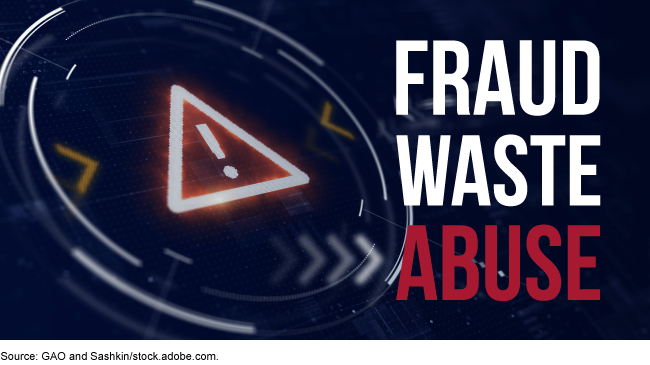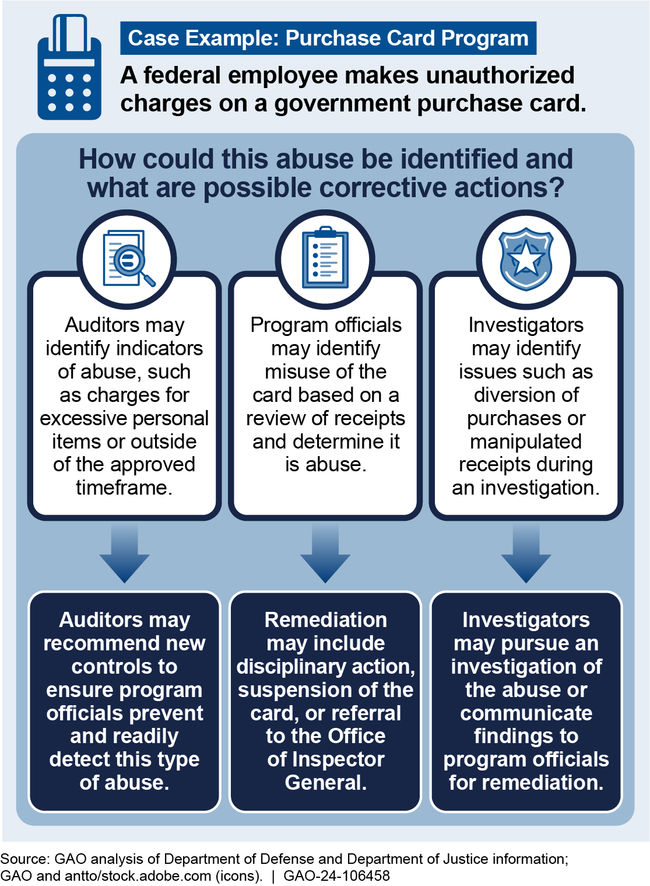GAOverview: Understanding Abuse of Federal Programs: Challenges Identifying and Determining Abuse of Federal Programs
Fast Facts
This GAOverview is part of our series aimed at helping officials better prevent and detect fraud, waste, and abuse. Abuse of federal resources occurs when someone behaves improperly or unreasonably, or misuses a position or authority.
We found 3 key challenges to identifying abuse of federal resources:
Officials don't always know what counts as abusive behavior based on program policies
Some programs and operations don't have as much oversight as others—making them prime targets for abuse
Some government activities—such as delivering foreign aid or domestic emergency response—may present unique risks of abuse

Highlights

Why This Matters
Abuse, while often present alongside fraud and waste, can itself cause substantial loss to the federal government. For example, the Veterans Affairs (VA) Office of Inspector General reported that potential abuse of overtime pay within one VA division cost the federal government as much as $23.8 million during fiscal years 2017 and 2018. Abuse can also be an indicator of further malfeasance as bad actors often abuse their authority to commit fraud and other crimes. Distinguishing abuse from fraud or waste can be difficult, requiring an assessment of the specific facts and circumstances. This GAOverview is part of a series aimed at helping officials better detect and prevent fraud, waste, and abuse.
What is Abuse of Federal Resources?
Abuse occurs when someone behaves improperly or unreasonably, or misuses a position or authority.
This includes intentional destruction, diversion, manipulation, or excessive use of government resources. Abuse involves deficient or improper behavior when compared with behavior that a prudent person would consider reasonable and necessary given the facts and circumstances. This definition can involve federal funds as well as goods and services not directly financial in nature. Program officials or the Office of Inspector General (OIG) are usually responsible for determining whether an action constitutes abuse within programs or operations.
Why is It Challenging to Identify and Determine Abuse of Federal Resources?
- Identifying abuse requires an understanding of an agency’s rules.
For example, agency rules may allow an employee to use a government vehicle for commuting. However, if the employee uses the vehicle for vacationing, it would be abuse. But what about using the vehicle to run an errand or stop for dinner on the way home? Would that be abuse? The agency can prevent abuse by helping employees understand the agency’s resource rules and any exceptions. The agency can also train staff on what abuse looks like in its programs. In this example, that might involve clarifying that an errand that is 1 mile or less out of the way is acceptable, or that no deviation from commuting is allowed. - The level of oversight and monitoring for abuse varies.
By law, some programs receive more monitoring. For example, the Government Charge Card Abuse Prevention Act of 2012 requires OIGs to monitor government charge card programs—like travel credit cards or purchase cards. Oversight to identify indicators of abuse can help agency officials better prevent or detect it. For example, indicators of charge card abuse include using a travel card to purchase personal items, or cash withdrawals while not traveling for work or of unusually high amounts. If indicators of credit card abuse are identified, OIGs might investigate further or recommend that agencies take actions to suspend an account, strengthen internal controls to prevent future abuse, or provide training to employees to clarify agency policies. - Different environments may present unique abuse risks.
The government has activities around the world, in many different environments. These different environments may present unique abuse risks. For instance, identifying and preventing abuse of US foreign aid can be challenging because bribery and corruption are more prevalent in some countries. If program officials do not fully understand the environment, for example through a risk assessment, the program and its success might be thwarted by abuse. Areas that have experienced disasters may also present unique abuse risks. Program officials may abuse their position to authorize disaster assistance for ineligible friends or family. Managers should establish a culture that advocates for zero tolerance of abuse.
Considerations for Better Identifying and Determining Abuse of Federal Resources
- Providing specific examples of what abuse could look like may help administrators better identify abuse and employ internal controls to prevent it.
For example, the Centers for Medicare & Medicaid Services (CMS) published in 2021 a booklet for medical providers with specific examples of what CMS considers to be abuse of the Medicare program. The booklet also provided CMS’s definition of abuse, an overview of related laws, and information on reporting suspected abuse. Tailoring such information to specific resources could help combat abuse in federal agencies. - Commonly abused resources may require officials to closely monitor activity and mitigate the abuse.
However, officials should consider the risk of abuse of all federal resources and take steps to mitigate it. Continual program monitoring, such as conducting periodic risk assessments and data analysis, allows program managers to promptly identify abuse and take corrective action. The figure shows how officials might identify purchase card abuse and possible corrective actions. - Although determining abuse may be difficult due to the varying circumstances in each case, consistent application of terminology and standards can help clarify what abuse means within the context of a specific program. This consistency allows program and oversight officials to better evaluate the circumstances, behaviors, and whether abuse occurred.

For more information, contact Rebecca Shea at (202) 512-6722 or shear@gao.gov.
